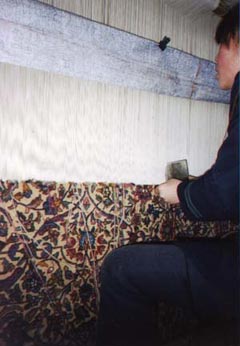|
|||||||||||||||||||||||||||||||||||||||||||||||||||||||||||
| |
|||||||||||||||||||||||||||||||||||||||||||||||||||||||||||
How Oriental Rugs are MadeContinued
Weavers are paid by the square meters plus a modest share of the weaving centers' profits. All workers participate in national holidays and are usually given some food coupons or sought-after food staples to take home to their families at Spring Festival, which is a lunar holiday in January or February. China adopted a five-day work week in 1995 and many of the workers now enjoy traveling during the weekend. Our rugs are removed from the loom after months of weaving and given a fresh wash to remove dust and stray yarns. This also tightens up the rug before final shearing and finishing. Our weavers use a double knotting technique to finish the warp ends into fringe. If you look at Atiyeh rugs you will notice we have a two-color interlace in the selvage. Each piece must undergo two rigorous quality control inspections, once at the weaving center and another at the warehouse prior to shipping. Every Atiyeh Oriental rug has our trademark woven (as seen in the crest at the top of each of these pages) into the border at one end, so you know we want everything with our name on it to be the best. If you want to see a video of our Oriental rug production, you can order a video tape from the gift shop that never closes. For those of you who have a specific question, you can send us e-mail from the where can I get it section. |
| Back to previous page. |

